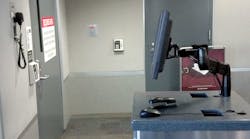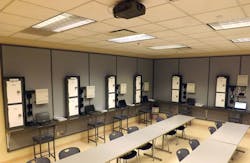After a long day at work, many of us come home and turn on the TV to catch up on what’s going on with the local news or around the nation. Unfortunately, more often than not, the top stories increasingly tend to report acts of violence at a workplace, a rash of burglaries, terrorist threats, and shootings in public places. The sad truth is our society has changed, and all of us need to be aware of the dangers we face day in and day out. Many homeowners and business owners are so aware of the need for security that they’ve elected to install security systems to protect their investments, family members, and employees.
There are many different systems that fall under the umbrella of security; however, for the purpose of this article, we will focus on intrusion detection systems and electronic access control systems. Intrusion detection systems are basically used to detect entry or attempted entry into a protected area. An electronic access control system is used to monitor and allow access to a secure area, if proper credentials (e.g., biometric, numerical code, access card, etc.) are presented.
Where are these systems used?
Intrusion detection systems are used in residential, commercial, and industrial applications. A residential application may only involve a few doors, motion detection, and glass break protection. In a commercial or industrial application, security may require a very large system that covers multiple doors, motion detection, glass break protection, perimeter protection (such as a fence), and hold-up or panic protection.
Electronic access control systems are more commonly installed in commercial and industrial facilities, such as airports, mass transit facilities, office buildings, manufacturing plants, schools, parking garages, and more. As with intrusion detection systems, access control systems may range from small to large areas of protection (Photo 1).
Regardless of the system’s size, intrusion detection and electronic access control systems can be very complex; therefore, trained and qualified professionals must perform the design, installation, and maintenance work.
What codes and standards apply?
There are many codes and standards that must be followed when installing security systems, including the NFPA Fire Alarm and Signaling Code (NFPA 72), International Building Code (IBC), Life Safety Code (NFPA 101), Americans with Disabilities Act (ADA), Standard for the Installation of Electronic Premises Security Systems (NFPA 731), and Guide for Premises Security (NFPA 730). Electrical workers must understand and apply all of these to ensure the security system installation meets minimum code requirements.
How do these systems work?
In addition to the codes and standards that must be followed in a security system installation, the electrical worker must have a fundamental understating of how a security system operates. This includes, but is not limited to, the theory of operation of the security system control panel, operation of input devices (door contacts, motion detectors, card readers, request-to-exit devices, and many other input devices), operation of output devices (door strikes and locking hardware, alarm outputs, and other output devices), and special circumstances that may arise during the installation.
Security system control panels can be very complex in nature and will require the electrical worker to completely understand how to program the system. Knowing the limitations of the system is also key. For example, the capabilities of the auxiliary power supply may not be adequate to provide power to all of the devices on the system. In this scenario, the electrical worker will be required to install an additional power source for the devices. This task requires a fundamental understanding of input devices and their limitations.
Another example might be a motion detector that is required to cover a long corridor and will require a specific motion detector for that application. If the same long-range motion detector was placed in a location that only requires a 20-ft range, the motion detector would be too sensitive.
Output devices require the same fundamental knowledge and may also require a specific device (such as a specific door strike) for the application. The electrical worker must understand how to properly wire all components for the security system (whether it is an intrusion detection system or an access control system). In addition, the electrical worker must continually adapt to changes in technology, which may require periodic manufacturer training.
Testing and troubleshooting
Many things can go wrong during a new electrical installation as well as with those that have been operating for some time. After the system is installed and programmed, it must be tested 100%. This means every device installed must be tested to make sure it functions as intended. For intrusion detection systems, the signals transmitted to a monitoring facility must be verified. For access control systems, the functionality of the locking devices must be tested. In addition, if the locking device is connected to the fire alarm system, the electrical worker must verify that the device unlocks when the fire alarm system is tripped.
Regardless of the problem or when it occurs, an electrical worker needs to identify where the problem exists and how to correct it. It’s also imperative that any training program you rely on addresses the proper procedures needed to effectively troubleshoot security system problems and how to perform preventive maintenance inspections on security systems. The maintenance inspections — similar to that of a fire alarm system — will verify that the batteries are functional and that all devices are in good working order and function as intended. Inspection tests will also require a visual inspection of the devices. For example, when performing a maintenance inspection on an access control system, the electrical worker may notice that a door strike is starting to have excessive wear because of the amount of use. This is a good opportunity to replace the device before it fails.
Hands-on training
Although there is no doubt that hands-on experience (Photo 2) trumps what can be accomplished in a lab environment, there are many training facilities around the country that have taken the lab experience to a new level. For example, some security training programs have developed hands-on lab training that simulates real-life security installations in a controlled environment. This allows electrical workers to apply theory, installation, and troubleshooting concepts in a truly interactive and safe environment that encourages a systematic approach to solving problems.
For instance, a lab may require the installer to simulate a large office building that requires complex programming and integration with another electrical system, such as a fire alarm system. Another may simply require that the intrusion detection system triggers an audible device when the system is tripped by an intruder. Both examples are real-life installations that provide the electrical worker with practical experience in a controlled environment. Another lab may require the electrical worker to diagnose or troubleshoot a problem that exists with the installation.
Without a doubt, students will make mistakes while going through the lab experience. However, it is better to make those mistakes in a controlled environment — where the instructor can point out issues and offer advice on corrective actions — as opposed to making them in a stressful job-site situation in the field. Mistakes on the job could cost the contractor money, delay a project, or possibly create a life-threatening situation.
Finally, don’t overlook the value of training offered by the manufacturing community. Many security manufacturers now require specific training on their products before they will provide support. One benefit of this requirement is you get to maintain your expertise level by taking part in these courses.
Simpson is a curriculum specialist with the National Joint Apprenticeship and Training Committee (NJATC) based in Upper Marlboro, Md. He can be reached at [email protected].





